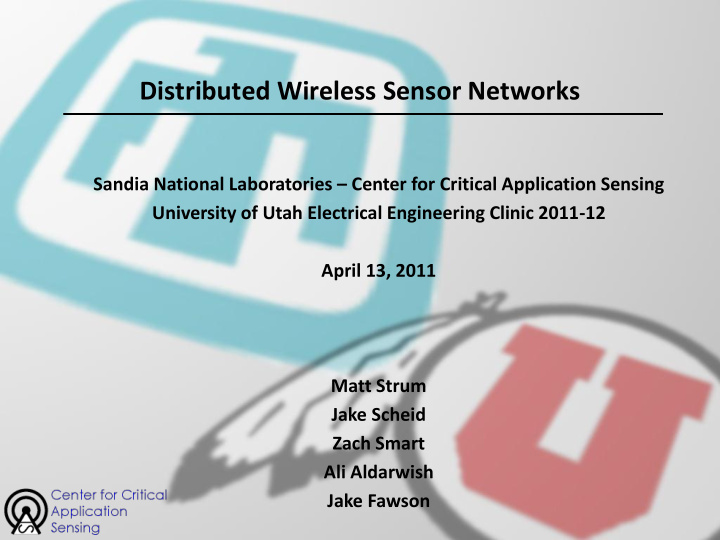



Distributed Wireless Sensor Networks Sandia National Laboratories – Center for Critical Application Sensing University of Utah Electrical Engineering Clinic 2011-12 April 13, 2011 Matt Strum Jake Scheid Zach Smart Ali Aldarwish Jake Fawson
Project Goals • Create a wireless sensor network using multiple “locally passive” sensor tags (specifically SAW devices) and an interrogation unit to protect an asset • At least three sensor types • Focus is on the system concept and possibilities, rather than the specific asset or scenario.
Project Description The useful life of distributed wireless sensor networks can be severely limited by the availability of power for the sensor nodes. This limitation can be overcome through the use of locally-passive sensor tags which can remain dormant and functional for long time frames. Our usage scenario is preventing assets within a closed facility from being removed. We want to be able to put our sensors on an asset, like a USB drive, without any need to worry about a power source or battery life. An interrogator would be located near an exit. Once powered on, the interrogator unit would constantly send and receive wireless signals to any asset within the transmitting range. That data would then be processed and transmitted wirelessly so that a security task force could monitor and act on the data.
Surface Acoustic Wave Filter • Surface Acoustic Wave (SAW) filters convert acoustic waves to electrical signals and vice versa by exploiting the piezoelectric effect of certain materials. – Input transducer converts electrical energy to mechanical energy (in the form of SAWs) – SAWs propagate over the substrate – Output transducer converts the SAWs back to electrical energy • Filters available through DigiKey
System
Tasking Ali, Jake, Jake, Zach Matt 1. DSP 2. Server 3. Client
Implementation Strategy 1. DSP – Three waves – Characterize signal data given by Sandia Labs • Over summer during internship in Cambridge – Modify to work with network analyzer during testing – Modify for final hardware 2. Server – Determine how/when to send updates – Tie in to sample data for simulation 3. Client – Listen to server updates and indicate to user
Schedule
Key Dates • Feb 8 – Kick-off meeting (Career Fair) • Mar 31 – Follow-up meeting (Technical Open House) • Finals end May 5 • Fall semester begins Aug 22 • Oct 4 – Conceptual design review (Career Fair) • Dec/Jan – Preliminary design review • Feb – Prototype demonstration and final design review (Career Fair) • Mar – Final demonstration and evaluation (Technical Open House)
Milestones • Requirements & functional analysis, system architecture design, identify risks, develop project plan and schedule Conceptual design review (Oct. 4) • Design, prototype, fabricate/load boards, program, etc. Preliminary design review (Dec/Jan) • Integration, revision, testing, validation, documentation Final design review (Feb) • Finish testing, documentation, demonstration Technical Open House (Mar)
Budget • $3,000 through the clinic program • We can arrange for loan of equipment if necessary (e.g., network analyzers)
Billing of Materials Item Quantity Description Price Total 1 1 Network Analyzer - U of U Microwave lab $0.00 $0.00 2 20 Sensor tags in the VHF and UHF frequency $10 $200 3 1 Mat lab - U of U Microwave lab $0.00 $0.00 4 7 SAW Antennas $15 $135 5 2 Proto-board $50 $100 6 1 VIA ARTiGO A1100 PC + HD/Memory $500 $500 7 1 Linksys WRT54GL 802.11b/g Wireless Broadband Router $56.99 $56.99 8 1 Substrate for System Mount $20 $20
Thank you! Any questions?
Recommend
More recommend